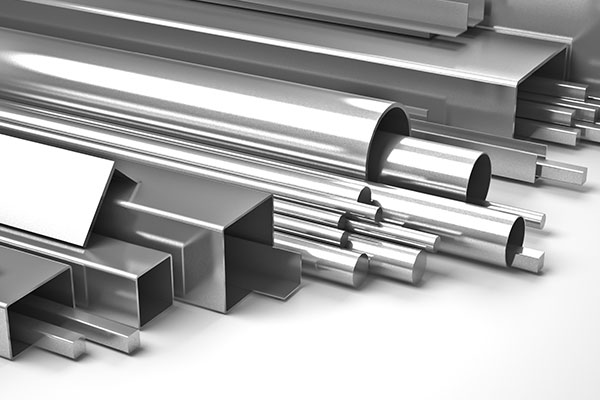HOME > Products > Stainless Steel

Stainless steel is relatively more resistant to rust and corrosion compared to regular steel.
Therefore, stainless is literally stainless and creates less rust, but does not prevent rust.
Stainless steel is different from carbon steel that contains no chrome. Carbon steel causes corrosion with exposed to air and humidity.
That generates iron oxide on the surface and accelerates the generation of more iron oxide.
Stainless steel containing chrome prevents chrome oxide from causing surface corrosion, and prevents corrosion from expanding into the overall structure of the metal.
In addition, allow steel of which chrome accounts for at least 12% for corrosion resistance is referred to as stainless steel, and diverse types of alloy such as Bb(beryllium), Ni(nickel), Mo(molybdenum, N(nitrogen), Ti(titanium) and Cu(copper) are added to enhance corrosion resistance and processability.
| Division | Name | Representative Steel Grade | Previous Steel Grade | Composition | Classification Based on Metallic Structures | |||
|---|---|---|---|---|---|---|---|---|
| Chrome-based | 13Cr-based | STS 410 | 51 Grades | 13% Cr | Martensite-based | |||
| 18Cr-based< | STS 430 | 24Grades | 18% Cr | Ferrite-based | ||||
| Chrome-Nickel-based | 18Cr-8Ni-based | STS 304 | 27 Grades | 18% Cr / 8% Ni | Austenite-based | |||
| STS 316 | 32Grades | 18% Cr / 8% Ni / 2.5% Mo |
||||||
| 16Cr-7Ni/1Al-based | STS 631 | - | 16% Cr / 7% Ni / 1%Al | Precipitation Hardening | ||||
| Types of Characteristics of Steel | STS 410 (13Cr-based) |
STS 430 (18Cr-based) |
STS 304, STS 316 (18Cr / 8Ni-based) |
STS 631 (16Cr-7Ni / 1Al-based) |
|||||
|---|---|---|---|---|---|---|---|---|---|
| Magnetism | Magnetic | Magnetic | Non-magnetic (However, it becomes a bit magnetic after cold processing.) |
Non-magnetic (However, it becomes a bit magnetic after heat-work hardening.) |
|||||
| Rust Status | It occurs occasionally. | Almost never occurs when used indoors, but occurs when used outdoors. | It is highly resistant to corrosion. | It is almost same as the 18 / 8-based. | |||||
| Impact, Extension | It is inferior to the 18 / 8-based. | It is inferior to the 18 / 8-based. | It is favorable and has excellent formability. | It shows high hardness and intensity after heat-work hardening. | |||||
| Thermal Expansion | It is almost same as common steel. | It is almost same as common steel. | It is approximately 1.5 times greater than that of common steel. | It is almost same as common steel. | |||||
| Thermal Conductivity | It is 1/2 times that of common steel. | It is 1/2 times that of common steel. | It is 1/3 times that of common steel. | It is 1/3 times that of common steel. | |||||
| Heat-work Hardening | Yes | No | No | Yes |
| Surface No. | Surface Status and How-to-process | Application |
|---|---|---|
| 1D | A product that is hot-rolled, then heat-processed and pickled, or processed in some way equivalent thereto | Industrial tank, chemical industrial apparatus, industrial facility material, and building structure material |
| HD | A product cold-rolled using work hardening that shows high hardness | High-hardness product, for spring, for knife, for railroad car, and for front base mount |
| 2D | A product that is hot-rolled, then heat-processed and pickled, or processed in some way equivalent thereto(favorable deep drawing) | For common use, for constructional use, petrochemical plant, and automotive part |
| 2B | A product made through 2D temper rolling which shows better gloss and surface smoothness than 2D and improved mechanical properties(cold rolling) | A representative cold-rolled product for common use that is applicable to almost all purposes |
| NO.3 | A product ground using 100~120-mesh sand paper in accordance with the KS L 6001(abrasive grain size) regulation and having beautiful gloss | Building interior/exterior materials, kitchen supplies, and electronic product exterior |
| NO.4 | A product ground using 150~180-mesh sand paper and having silver-white surface that is smoother than No. 3 | For constructional use, kitchen supplies, for vehicle, medical device, food facility, and tub |
| BA | A product cold-rolled, then bright-heat-treated and temper-rolled and showing high-degree reflectivity and gloss | Automotive part, home appliances, kitchen supplies, decorations, for constructional use, and small mirror |
| HL | A product ground to have consecutive abrasive patterns by applying an abrasive with an adequate grain size to a No. 4 product | Building interior/exterior materials such as sash, door and panel |
| NO.8 | A product ground to have substantial gloss and reflex function that is ground by rotating the buff with an 800-mesh(or above) abrasive (dry type) | For constructional use, reflector, for front base mount, and for decoration |
| MR | A product ground to have high-degree gloss and reflex function that is consecutively processed and ground by rotating the buff with a 1000-mesh(or above) abrasive and has almost no trace of grinding (dry type) | For constructional use, reflector, for front base mount, and for decoration |